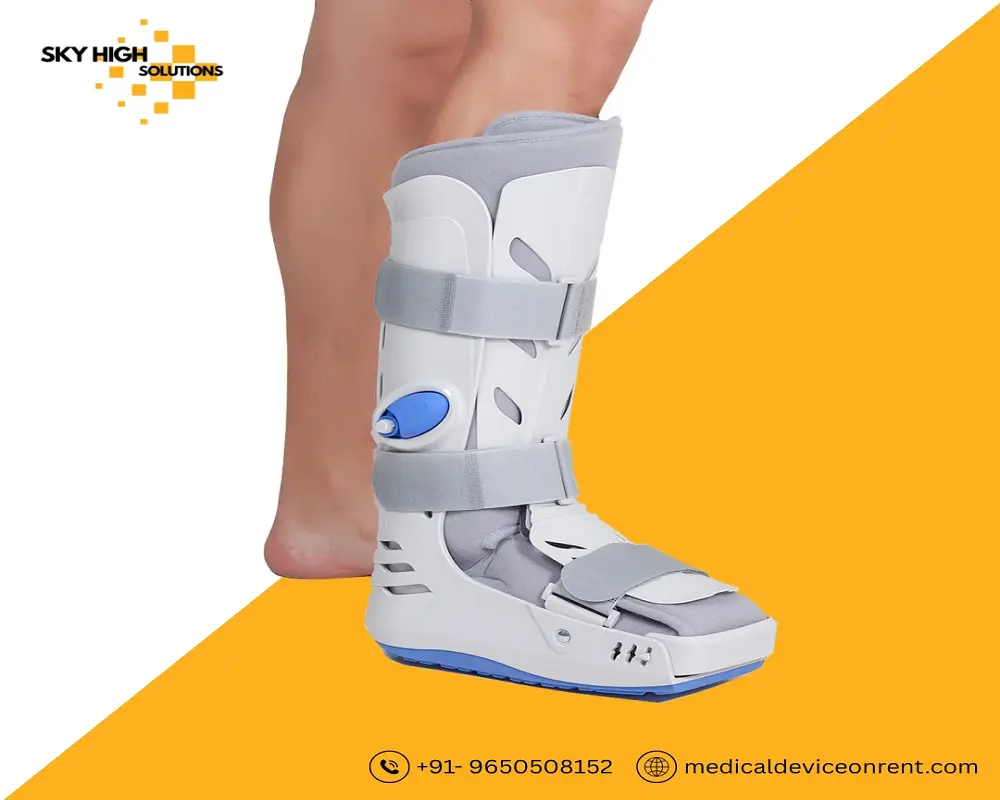When recovering from an injury or surgery, protecting and supporting your foot or ankle is crucial for a successful recovery. One of the most effective solutions available today is the pneumatic walker boot—an advanced orthopedic device designed to provide stability, comfort, and controlled compression.
Whether you are looking for an air walker boot for short-term use or exploring pneumatic walker boot uses for post-surgical recovery, this detailed guide will help you understand everything about this essential medical device.
What Is a Pneumatic Walker Boot?
A pneumatic walker boot—also known as an air walker boot, pneumatic boot, or pneumatic walking boot—is a specialized orthopedic boot designed to protect the lower leg, ankle, or foot after an injury or surgery.
It typically features:
- A rigid outer shell for protection and stability
- An inflatable air bladder (pneumatic feature) to provide adjustable compression
- Cushioned inner lining for comfort
- Adjustable straps for secure fit
The air bladder allows you to control the level of compression, helping to reduce swelling and promote healing. You may also hear terms like surgical boot, easycast pneumatic walker, or pneumatic shoes used interchangeably.
Pneumatic Walker Boot Uses
A pneumatic walker boot is prescribed for a variety of medical conditions and recovery needs. Common pneumatic walker boot uses include:
1. Fractures
-
Stress fractures of the foot or ankle
-
Metatarsal fractures
-
Non-displaced tibia or fibula fractures
2. Post-Surgical Recovery
-
After foot or ankle surgery to stabilize the area and control swelling
-
Helps to gradually transition back to weight-bearing
3. Severe Sprains & Soft Tissue Injuries
-
Grade 2 or 3 ankle sprains
-
Ligament or tendon injuries requiring immobilization
4. Diabetic Foot Ulcers
-
Offloading pressure to allow ulcers to heal safely
5. Achilles Tendonitis & Post-Tendon Repair
-
Providing controlled support during the healing process
A walker boot can be an alternative to a hard cast in many cases, offering more flexibility, comfort, and ease of use.
Benefits of a Pneumatic Walker Boot
Using a pneumatic walker boot during recovery provides many advantages over traditional methods like casting or standard braces:
Adjustable Compression
The built-in air bladder allows the patient or caregiver to adjust the level of compression, helping to manage swelling effectively.
Improved Comfort
Unlike a hard cast, a pneumatic boot has a cushioned inner liner and adjustable fit, enhancing patient comfort.
Mobility Support
Many pneumatic walking boots feature rocker soles that promote a natural walking motion, allowing for limited mobility even during recovery.
Easy to Remove
You can remove the boot for bathing, dressing changes, or gentle physical therapy as advised by your doctor.
Better Hygiene
Being able to take off the boot periodically improves skin hygiene, which is not possible with traditional casts.
Types of Pneumatic Walker Boots
Several models and brands of pneumatic walker boots are available, including the popular Easycast pneumatic walker. Here are some common types:
1. Standard Pneumatic Walker Boot
-
Provides basic immobilization and compression
-
Lightweight and comfortable
2. Short Pneumatic Walker Boot
-
Designed for foot injuries where calf immobilization isn’t needed
-
Easier to wear for shorter patients
3. Tall Pneumatic Walker Boot
-
Provides extended support to the calf
-
Suitable for severe injuries or post-surgical recovery
4. Diabetic Pneumatic Shoes
-
Designed specifically to offload pressure from ulcers and wounds
-
Often used in conjunction with wound care treatments
How to Choose the Right Pneumatic Walker Boot
When selecting a pneumatic walker boot, consider the following:
Injury Type
Your healthcare provider will recommend the right model based on your injury or surgical procedure.
Correct Size
Proper sizing is crucial for comfort and effectiveness. Measure your foot and follow manufacturer sizing guides.
Air Bladder Design
Look for boots with easily adjustable air chambers to fine-tune compression as your swelling changes.
Sole Type
If mobility is a concern, choose a boot with a rocker sole for a more natural gait.
Rental vs. Purchase
For short-term recovery, renting a pneumatic walker boot can be a cost-effective option.
Why Rent a Pneumatic Walker Boot in Gurgaon?
At Medical Device on Rent, we understand that purchasing a high-quality pneumatic walker boot may not always make sense—especially for short-term needs.
Renting a walker boot allows you to:
-
Access premium-quality devices at affordable rates
-
Pay only for the period you need the boot
-
Receive expert guidance on fit and usage
-
Avoid the hassle of storing or reselling the device after recovery
How to Use a Pneumatic Walker Boot
Follow these steps to ensure proper usage:
-
Wear a soft sock under the boot to protect your skin.
-
Place your foot in the boot and secure all straps.
-
Use the built-in pump or valve to inflate the air bladder to a comfortable compression level.
-
Follow your doctor’s instructions regarding weight-bearing.
-
Regularly check your foot for signs of pressure or skin irritation.
-
Deflate and remove the boot as advised for hygiene and dressing changes.
Conclusion
A pneumatic walker boot is a versatile and highly effective device for managing a wide range of foot and ankle injuries. From fractures and sprains to post-surgical recovery and diabetic foot care, this advanced boot offers adjustable support, comfort, and mobility during healing.
If you are looking for a reliable and affordable way to access a walker boot, consider renting from Medical Device on Rent in Gurgaon. Our team is here to help you select the right equipment and ensure your recovery is smooth and comfortable.
Contact us today to learn more about renting a pneumatic walking boot or any other medical equipment you may need!

